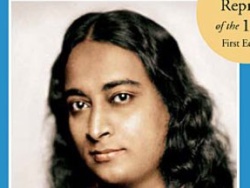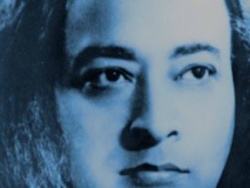
“The purpose of the guru is not to weaken your will. It is to teach you secrets of developing your inner power, until you can stand unshaken amidst the crash of breaking worlds.”Paramhansa Yogananda
Jesus Christ
 “In the divine plan, Jesus Christ was responsible for the evolution of the West, and Krishna (later, Babaji), for that of the East. It was intended that the West specialize in developing objectively, through logic and reason, and that the East specialize in inner, intuitive development. But in the cosmic plan the time has come to combine these two lines into one. East and West must unite.”
“In the divine plan, Jesus Christ was responsible for the evolution of the West, and Krishna (later, Babaji), for that of the East. It was intended that the West specialize in developing objectively, through logic and reason, and that the East specialize in inner, intuitive development. But in the cosmic plan the time has come to combine these two lines into one. East and West must unite.”
—Paramhansa Yogananda, Autobiography of a Yogi
The presence of Jesus on the altar is more than just a courtesy to Westerners. Yogananda ji said it was Jesus himself who appeared to Babaji and asked him to send this teaching of Self-realization to the West. Jesus said to Babaji, “My followers have forgotten the art of divine inner communion. Outwardly they do good works, but they have lost sight of the most important of my teachings, ‘to seek the kingdom of God first.’”
Mahavatar Babaji
 Babaji simply means “revered father.” Though the great master’s birth name and date are unknown, he is known to occasionally appear to advanced yogis in the Himalayas along with a small group of his disciples. After the vision of Jesus, Babaji agreed to send someone in his lineage to the West, although the person he would choose was not yet born. Babaji is the one credited with bringing back the ancient science of Kriya Yoga. Babaji is sometimes referred to as Babaji-Krishna because Babaji is known to have said that he was Krishna in a previous lifetime.
Babaji simply means “revered father.” Though the great master’s birth name and date are unknown, he is known to occasionally appear to advanced yogis in the Himalayas along with a small group of his disciples. After the vision of Jesus, Babaji agreed to send someone in his lineage to the West, although the person he would choose was not yet born. Babaji is the one credited with bringing back the ancient science of Kriya Yoga. Babaji is sometimes referred to as Babaji-Krishna because Babaji is known to have said that he was Krishna in a previous lifetime.
Lahiri Mahashaya (1828 - 1895)
 Shyama Charan Lahiri was the birth name of this great yoga master. His disciples lovingly added “Mahasaya,” which means “great-minded one.” Born in Bengal, India, to a pious brahmin family, Lahiri Mahasaya was the one who made the ancient science of Kriya Yoga available not just to those who had renounced the world, but to all sincere souls.
Shyama Charan Lahiri was the birth name of this great yoga master. His disciples lovingly added “Mahasaya,” which means “great-minded one.” Born in Bengal, India, to a pious brahmin family, Lahiri Mahasaya was the one who made the ancient science of Kriya Yoga available not just to those who had renounced the world, but to all sincere souls.
Lahiri Mahasaya was a married householder with two sons. He held a job as an accountant to support his family. A yoga master of the highest achievement, his entire life served as an example of how to live “in the world, yet not of the world.”
Lahiri met Babaji when he was in his 30’s, and through a wondrous initiation described in Autobiography of a Yogi by Paramhansa Yogananda, he became Babaji’s disciple. One of his foremost disciples was Sri Yukteswar, the destined guru of Paramhansa Yogananda.
Sri Yukteshwar (1855 - 1936)
 “He fitted the Vedic definition of a man of God. ‘Softer than the flower where kindness is concerned, stronger than thunder, where principles are at stake.’ He taught by sublimity of example alone the true measure of a man.”
“He fitted the Vedic definition of a man of God. ‘Softer than the flower where kindness is concerned, stronger than thunder, where principles are at stake.’ He taught by sublimity of example alone the true measure of a man.”
—Paramhansa Yogananda, Autobiography of a Yogi
Swami Sri Yuketwar of Serampore, India was a disciple of Lahiri Mahasaya and the guru of Paramhansa Yogananda. An “incarnation of wisdom,” he possessed a keen intellect and discrimination. He received two commissions from Babaji. One was to write “a short book on the underlying unity between the Christian and Hindu scriptures, to show that the inspired sons of God have spoken the same truths.” This book is The Holy Science. The second was to train Yogananda for his mission to the West.
Early in life, Yukteswar was married; later he became a renunciate and lived in his hermitage near Calcutta, India. Sri is a respectful title meaning “holy.” Yukteswar means “united to Ishwara” (the name of God in his aspect as the Cosmic Ruler).
Paramhansa Yogananda (1893 - 1952)
 “The vibrations of many spiritually seeking souls come floodlike to me. I perceive potential saints in America and Europe, waiting to be awakened.” Said Babaji to Yogananda: “You are the one I have chosen to spread the message of Kriya Yoga in the West.”
“The vibrations of many spiritually seeking souls come floodlike to me. I perceive potential saints in America and Europe, waiting to be awakened.” Said Babaji to Yogananda: “You are the one I have chosen to spread the message of Kriya Yoga in the West.”
—Paramhansa Yogananda, Autobiography of a Yogi
Yogananda came to America in 1920 not to “dogmatize you with a new theology,” as he later told his students, but “to teach you how to commune with God directly.” He lectured to hundreds of thousands throughout the country. His Autobiography of a Yogi, first published in 1946, has become one of the most well-read spiritual books of the last century, and a classic of religious literature. He was devoted to helping unite East and West by bringing the original teachings of yoga to the West and showing their underlying unity with the original teachings of Christ. He advocated the founding of what he called “world-brotherhood colonies” where people could live together in spiritually supportive communities.
Yogananda means “Divine Bliss through Yoga.” Paramhansa means “highest swan.” The white swan or hansa is said to have the power of extracting only milk (wisdom, enlightenment) from a mixture of milk and water (the mundane world), and is a symbol of spiritual discrimination.








